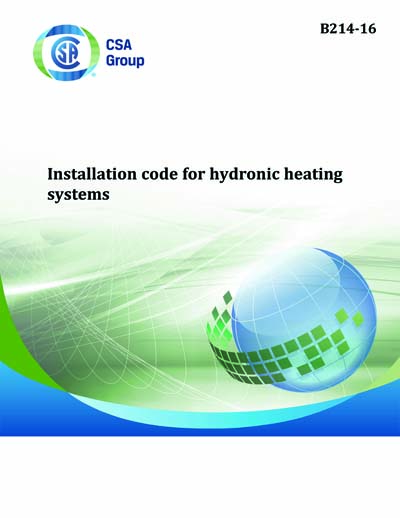Historical
CSA B214-2016
B214-16 - Installation code for hydronic heating systems
Preface
This is the fourth edition of CSA B214, Installation code for hydronic heating systems. It supersedes the previous editions, published in 2012, 2007, and 2001. The main changes from the previous edition are as follows: a) clarification of the use of storage-type dual-purpose water heaters; b) clarification of oxygen diffusion barriers; c) clarification of requirements for hydronic fluid quality; d) inclusion of polyethylene of raised temperature (PE-RT) tubing and tubing fittings; e) clarification of requirements for return-water low-temperature protection; f) clarification of insulation requirements; g) clarification of requirements for tube fasteners; h) inclusion of snow and ice melting systems as stand-alone systems; i) clarifications of auxiliary systems; j) clarification of radiant under-floor heating and floor surface temperatures; k) revisions to nominal tube sizing in Table 1; l) revisions to loop lengths for snow and ice melt systems in Table 3; m) inclusion of Annex C with guidelines related to radiant surface cooling; and n) inclusion of Annex D with guidelines related to minimum flow rates for heat distribution.Scope
1.1 This Code sets out the minimum provisions for the installation, extension, alteration, and renewal of hydronic heating systems. 1.2 This Code applies to open and closed hydronic heating systems. These systems include a) hydronic space heating; b) radiant heating (wall, floor, ceiling); c) convectors; d) fan coils; e) combination potable water heating and space heating (combo) systems; f) integrated mechanical systems; g) indirect-fired domestic water heating; h) pool and spa heating; i) snow and ice melt systems; and j) other auxiliary systems. 1.3 The terms pipe and piping, as well as tube and tubing, are used interchangeably in this Code, unless otherwise stated. 1.4 In this Code, shall is used to express a requirement, i.e., a provision that the user is obliged to satisfy in order to comply with the Code; should is used to express a recommendation or that which is advised but not required; and may is used to express an option or that which is permissible within the limits of the Code. Notes accompanying clauses do not include requirements or alternative requirements; the purpose of a note accompanying a clause is to separate from the text explanatory or informative material. Notes to tables and figures are considered part of the table or figure and may be written as requirements. Annexes are designated normative (mandatory) or informative (non-mandatory) to define their application. 1.5 The values given in SI units are the units of record for the purposes of this Code. The values given in parentheses are for information and comparison only.Content Provider
CSA America, Inc. [csa]






